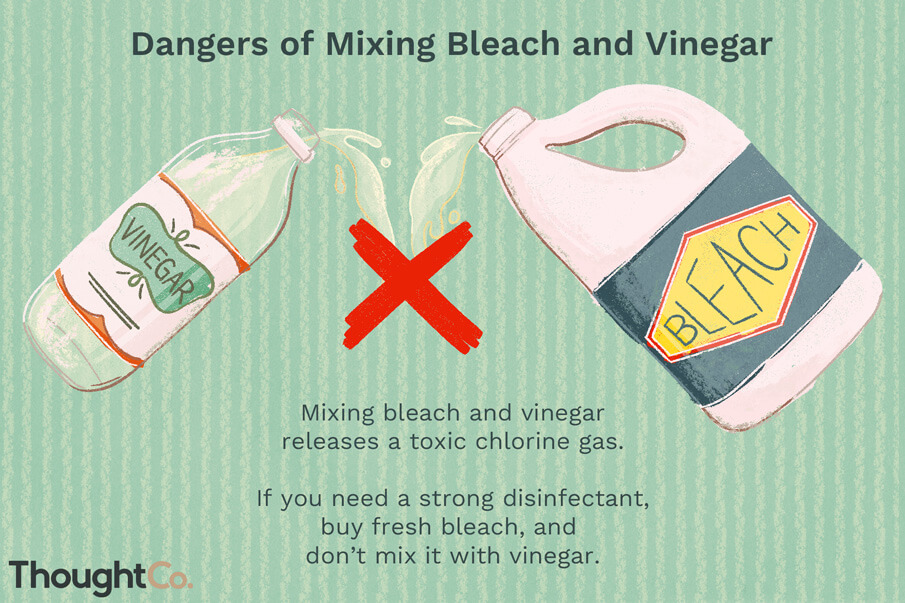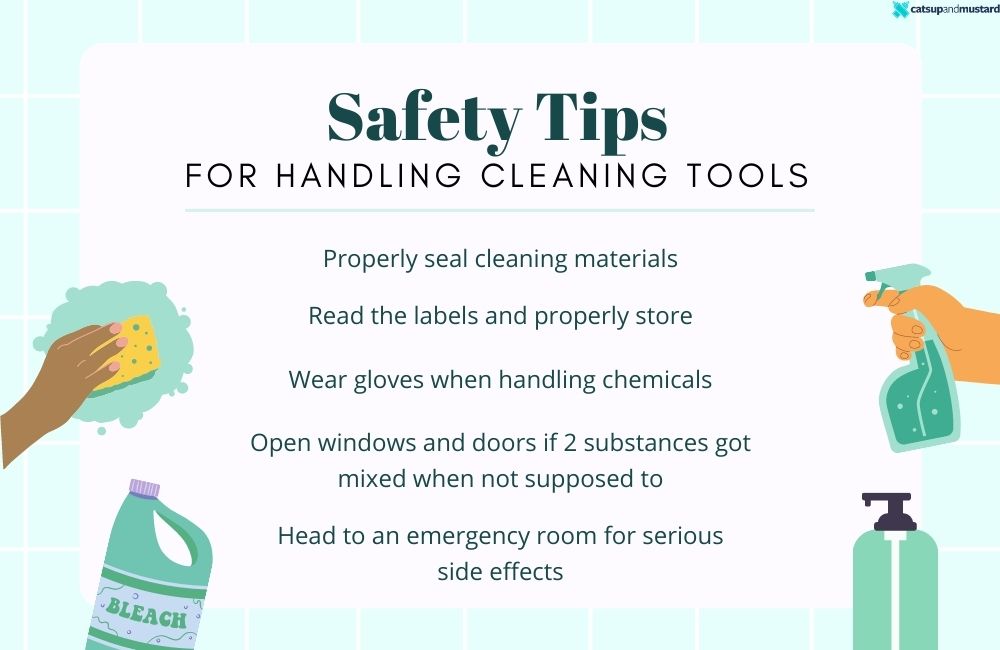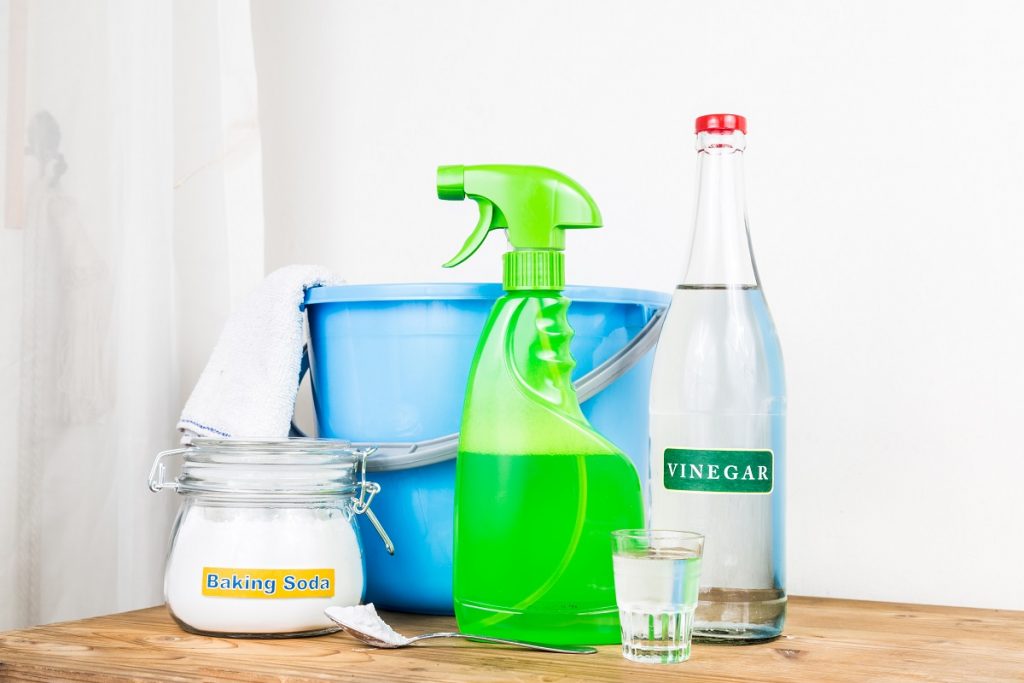These days, the internet is full of DIY hacks for almost anything, including cleaning your home. These hacks promise cheaper but more effective ways to clean your home using common household items you already have. These are supposedly the greener alternatives to commercial products for cleaning your bathroom, kitchen, and other areas.
But not all these hacks are effective; in fact, some of them may be dangerous. For instance, can you mix bleach and baking soda? You can. But can you mix bleach with vinegar? No. In fact, you should never mix bleach with any other cleaning agent.
Here’s a list of DIY cleaning agents, debunked, and why you should NOT combine these two together.
Bleach and Baking Soda

Mixing bleach and baking soda has no harmful effects, and baking soda may probably be the only cleaning agent you can safely mix with bleach. This is because this mixture won’t react badly and create toxic gases like chloramine the way other cleaning agents do.
This is a common DIY cleaning hack for many people laundering white clothes. Add half a cup of bleach and half a cup of baking soda to your white laundry. The baking soda eliminates most of the strong bleach scent while boosting the bleach’s cleaning abilities. The result: whiter, fresher clothes. This is great for white clothes that have discolored with time.
Mixing bleach and baking soda is also good for cleaning walls that are dirty and have molds. In a mixing bowl, pour a cup of baking soda and add just enough bleach to create a paste. Make sure to put on a face mask, gloves, and safety goggles as you’ll be using this on molds, which can create a chemical reaction. If the room doesn’t have a ventilation grate or fan, keep the doors and windows open.
Spread the paste on the walls and scrub with a stiff brush. Scrub until the mold is gone. Leave the room and wait for the paste to dry.
Hydrogen Peroxide and Vinegar
Mixing hydrogen peroxide and vinegar is not toxic in the sense that thin mists of these two on a surface are not toxic. But do not mix these two in one container. Combined in large amounts, they create peracetic acid, which can be toxic and cause irritation to your skin and eyes and serious effects on your respiratory system.
Separately, peroxide and vinegar are good natural disinfectants. Vinegar is acidic, which can kill most bacteria and germs, while hydrogen produces free oxygen radicals that destroy bacteria’s composition.
To use both safely, spray a thin layer of vinegar onto a surface. Let it sit for a few seconds before spraying with a 3% peroxide solution.
Bleach and Vinegar

Can you mix bleach and baking vinegar? No, and you should not try this or keep these two stored close to each other in a non-ventilated storage area.
These two are powerful disinfectants, so some may think that mixing them (just like mixing bleach and baking soda, which is safe) will make it even stronger. But combining them produces chlorine gas, which is toxic at high levels. In smaller amounts, it can cause coughing, minor breathing problems, and stinging watery eyes.
Ammonia and Bleach
No, do not mix ammonia and bleach together. In fact, keep it as far away from each other when storing your cleaning supplies. When combined, it creates chloramine, a toxic gas that can cause respiratory problems.
In fact, this is the reason you should never mix bleach with any other cleaning product aside from baking soda. Many commercial cleaning products contain ammonia, which can produce chloramine. So, it’s best to be safe and not mix bleach with any other product.
Multiple Drain Cleaners
Commercial drain cleaners are made from different ingredients, so there’s no telling whether or not it’s safe to mix them with other substances. In case one drain cleaner doesn’t work, do not try to mix another. Call a plumber to treat your clogging.
Bleach and Alcohol

Mixing bleach and rubbing alcohol produces chloroform, more popularly known as that substance used by kidnappers and abductors to knock out people. It may not knock you out immediately, but it can be very irritating and toxic when produced in large amounts.
Bleach and Toilet Bowl Cleaner
Toilet bowl cleaners may contain ammonia, acids, alcohol, and many other substances that react badly with bleach. These can be very dangerous. Stick to one substance when cleaning your toilet. Or, apply bleach to your bowl first and let it sit for 15 minutes before flushing it away. Use a toilet bowl cleaner after.
Safe DIY Cleaning Materials
Not all DIY hacks are bogus, though. Instead of mixing harmful substances, here are natural cleaning products you may already have at home.
Baking Soda
White Vinegar
You can also replace this with apple cider vinegar or lemon juice. These are non-toxic organic disinfectants because of their acidic properties. Do not use any other type of vinegar.
Hydrogen Peroxide

On its own, it’s also a good cleaning agent AND first-aid tool. For the ladies, hydrogen peroxide is a great tool to have during your period. This can remove blood stains on your underwear, bottoms, and bedsheets. Pour a little on the spot, wait for it to bubble, and dab the stain away with a cotton pad.
Salt
Salt is a great natural abrasive on its own and can help other natural cleaning agents like vinegar. Pour salt over a stain and use a stiff brush to scrub.
Safety Tips for Handling Cleaning Tools

- Make sure your cleaning materials are properly sealed when not in use. Ideally, store your chemicals in a well-ventilated room or in appropriate storage to keep it at room temperature. Keep your containers out of reach for children.
- Read the labels on your products and store accordingly. This may mean keeping your containers away from certain temperature or other substances.
- Always wear gloves when handling chemicals.
- In case you do accidentally mix two substances that shouldn’t be mixed, open all windows, open the doors, and open all forms of ventilation. Leave the room immediately and wait for the gasses to subside before disposing of it carefully.
- In case you feel serious side effects, head to an emergency room immediately.
When in doubt, it’s much better to use one cleaning agent (whether it’s a commercial cleaning product or a natural DIY cleaning product you can find at home) than to mix several cleaning agents together. If you’re unsure, never mix two substances together and always wear the right protective gear when handling these chemicals.

